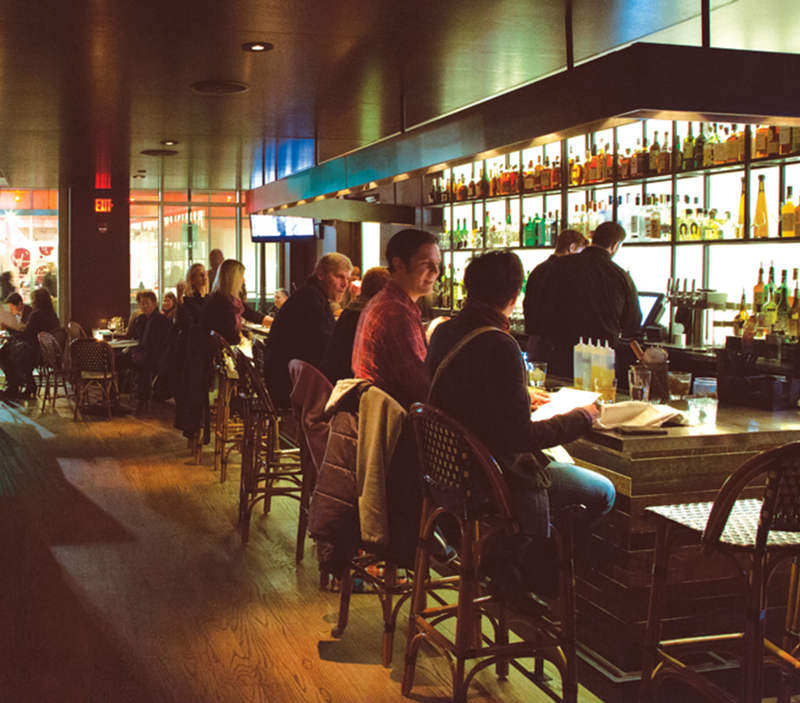D
owntown Cincinnati could soon get 21 more liquor licenses under a new proposal pending state approval. Boosters, including Mayor John Cranley and Cincinnati Center City Development Corporation, say the extra licenses gained by defining much of downtown as two Community Entertainment Districts will boost economic development and create jobs.
But the plan has brought up questions about how many bars are too many and whether parts of the proposal really serve the purpose for which CEDs were designed. As Cincinnati’s neighborhoods continue to see new development mostly driven by restaurants and bars, some question the wisdom of adding even more liquor licenses downtown. Meanwhile, others criticize a provision they say gives developer 3CDC control over six of the potential licenses.
Under the new plan, a portion of downtown near the convention center and Dunnhumby’s new headquarters would be known as the Downtown East Entertainment District. It would get 16 more licenses, which would be available to existing and prospective local businesses, including establishments currently only open during lunch hours that would like to expand their business by offering alcohol to after-hours crowds. Another district called Downtown West would get six additional licenses for the currently in-progress Dunnhumby Center, all controlled by developer 3CDC.
“I believe that it violates the spirit of community entertainment districts and that the grace we’ve been given could be taken away because of perceived abuse by the state,” Councilwoman Yvette Simpson said of the developer-controlled licenses. “I don’t want to be complicit in that.”
But 3CDC head Steven Leeper challenges that assertion and says both the east and west districts will help get licenses to local businesses.
“We’re not interested in controlling liquor licenses,” Leeper said. “This is a means to an end. We have several terrific restaurateurs, small businesspeople. Everyone we’re talking to who is going into this site is from Cincinnati.”
There are also questions about economic viability. Currently, the 45202 zip code, which includes downtown and Over-the-Rhine, has 92 liquor licenses. Some, including current bar owners in places without CEDs like Mount Adams and Clifton, wonder if the market could be flooded by the increase in licenses. Some council members had the same questions, as well as concerns about how to revoke licenses if they aren’t used responsibly.
“There’s a surprising lack of information about when we reach a saturation point on the issuance of liquor licenses,” said Councilman Kevin Flynn. “When I looked at these two districts I saw that the west district consists of the hotels and the convention center that already have licenses of a different nature. That concerned me.”
Stuart Wilson, a research associate at the University of Cincinnati Economics Center for Education & Research, says it’s hard to know how many bars downtown can support without detailed research. But he says the plan could thin out crowds at busy bars at first while eventually increasing business if more folks move downtown or visit to patronize businesses more often.
“Generally speaking, many bars already are packed beyond capacity limits on busy weekend nights and are relatively empty on weekdays,” Wilson says. “In the short run, adding more bars would likely dilute these numbers. However, there may be secondary impacts. ... To the extent that this plan succeeds in attracting new residents and visitors, it could potentially cause a net increase in the number of individuals served per license.”
Flynn, who voted for the proposal, said he would like more information on the economic viability of so many alcohol-related establishments downtown. He also stressed how hard it can be to get rid of a liquor license, citing a case between the city and state over a carry out store in the West End. The city denied Jet In Market’s request to renew its liquor license in 2007 after police found drug dealing and other criminal activity happening there. However, the state overturned the city’s decision, and now, eight years later, the two are still wrangling in court.
Defenders like Mayor Cranley wave off concerns about the proliferation of licenses and whether they’re controlled by developers or not. Cranley says the districts are about creating economic development around the state’s archaic liquor laws.
“This isn’t about supporting this developer or that developer,” Cranley said at the Feb. 25 Cincinnati City Council meeting at which the proposals were passed. “This is about whether there should be a cap on liquor licenses or not. Let a thousand flowers bloom. Let the market determine which bars should succeed and fail.”
Ohio is one of 17 states that limits the number of liquor licenses a city can receive. Municipalities are limited to one per 2,000 residents, and with 161 for bars and restaurants, Cincinnati is currently over its limit, which shrank to 149 as the city’s population declined.
Ohio’s cap on liquor licenses is a holdover from the country’s immediate post-prohibition years, when lawmakers tried to navigate a compromise between the country’s distaste for its alcohol ban with the lingering political power of the temperance movement.
The license caps have remained stubbornly lodged in the state’s legal code due to the vested interests of distributors and current license holders who have big money at stake in the system as it stands. If the number of licenses in the state goes up as the cap is eliminated, those who hold licenses now worth tens of thousands of dollars could see their value deflate significantly. They would also face a rush of new business competition.
With 12 extra licenses above the state’s cap in the city and no end to the caps in sight, it could be years before someone looking to go through the state’s liquor license application process would be issued a new one at a cost of more than $2,000 a year. The alternative is to buy a license on the open market, the cost of which averages about $20,000 in the Cincinnati area, presenting a big barrier to small businesses looking to get their start.
That’s where CEDs come in. They allow a city to get more liquor licenses than normally stipulated under state law, but only in specific neighborhoods. Cincinnati’s first CEDs were two districts at The Banks created in 2008. In 2010, council made it much cheaper for applicants looking to revitalize the city’s neighborhoods to apply for a CED, lowing the cost from $15,000 to $1,500.
Since that time, the city has named 10 more districts in Northside, Over-the-Rhine, Walnut Hills, Pleasant Ridge, CUF, Madisonville, East Price Hill, Short Vine, College Hill and 3 East, a district encompassing East Side neighborhoods East End, Columbia Tusculum and Linwood.
So far, community leaders in many of those neighborhoods have been pleased with the results of the districts.
“It’s been a boom for Northside,” says Northside Community Council President Oliver Kroner. “Our neighborhood appeals to startups and young businesses — anything to help reduce startup costs helps bring these efforts to life. The CED has added to the variety of dining/entertainment options in Northside, drawing in new patrons. It really has created a ‘district’ attracting people from all over the city.”
Kroner acknowledges that there have been some minor problems with parking and that occasionally residents express reservations about yet another new restaurant or bar, but he says the community is finding other ways to address those issues and is overall very supportive of the district.
Former Walnut Hills Area Council President Kathy Atkinson says the Community Entertainment District designation has been good for the neighborhood, driving increased foot traffic and interest in more development. But she says the CED is just one tool among many that communities should utilize to spur revitalization and that the process by which communities arrive at the designation is vital.
Atkinson stressed that various civic groups, including the community council and the Walnut Hills Redevelopment Foundation, spent months engaging the community to get perspective from residents and business owners. They worked with residents to address concerns about security and hours of operation for new businesses brought into the neighborhood by the district designation and how those businesses would fit into the existing fabric and character of the community.
“It is a tool that should be considered with respect to the initial gains for increased commerce while discerning how it fits into the long-term vision for the community,” Atkinson says. “As with any neighborhood revitalization, any tool in the tool kit is only successful if folks understand how to use the tool and then actually use it appropriately.” ©






